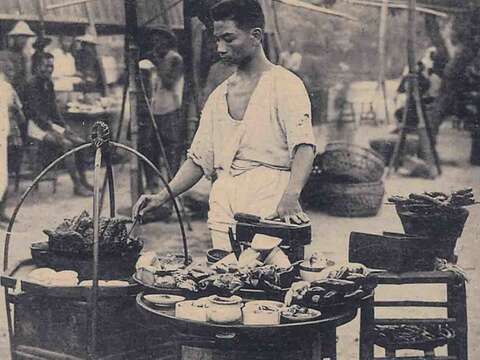Post date:2016-06-17
Updates:2016-08-23
1805
Article/Photos: Kao Chuan-chi (senior guide specializing in Taipei's historical areas)
Bangka is a historical, cultural, and architectural landscape, with too many types of snacks and delicacies to count. In the past, not many domestic or foreign tourists explored the streets on their own to gain a true understanding of this neighborhood. When the movie Monga hit theaters in 2010, it not only introduced Taiwanese people to this old area of Taipei, but also brought a wave of tourism to Wanhua.
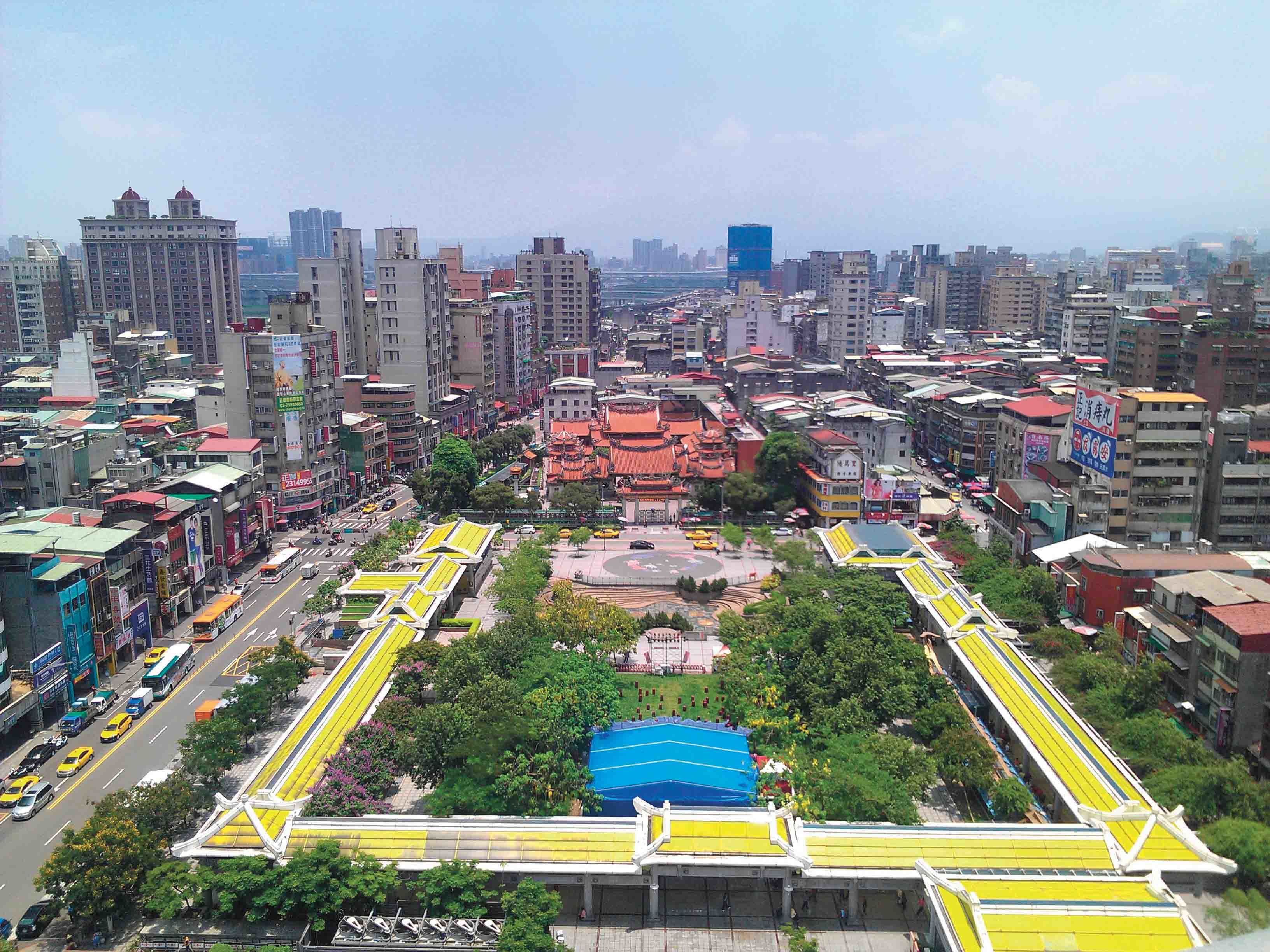
Bangka’s historical and cultural landscapes are abundant and diverse. However, in the past there were not many
domestic or foreign tourists who walked this area on their own.
In addition to praying for peace, happiness, and success at Longshan Temple, tourists began to visit some of the film's locations, such as the home of gang leader Geta in the Bopiliao Historic Block, the Taiyang Book Binding Factory, the place where members of the “Gang of Princes (太子幫)” were sworn in, Bangka Zushi Temple, the Huaxi Street Tourist Night Market, where gang fights took place, the alley adjacent to the Kushanyuan Hotel (古山園旅社) and Baodou Li ( 寶斗里), where the male and female leads met and developed feelings for one another. All of these places have become popular attractions.
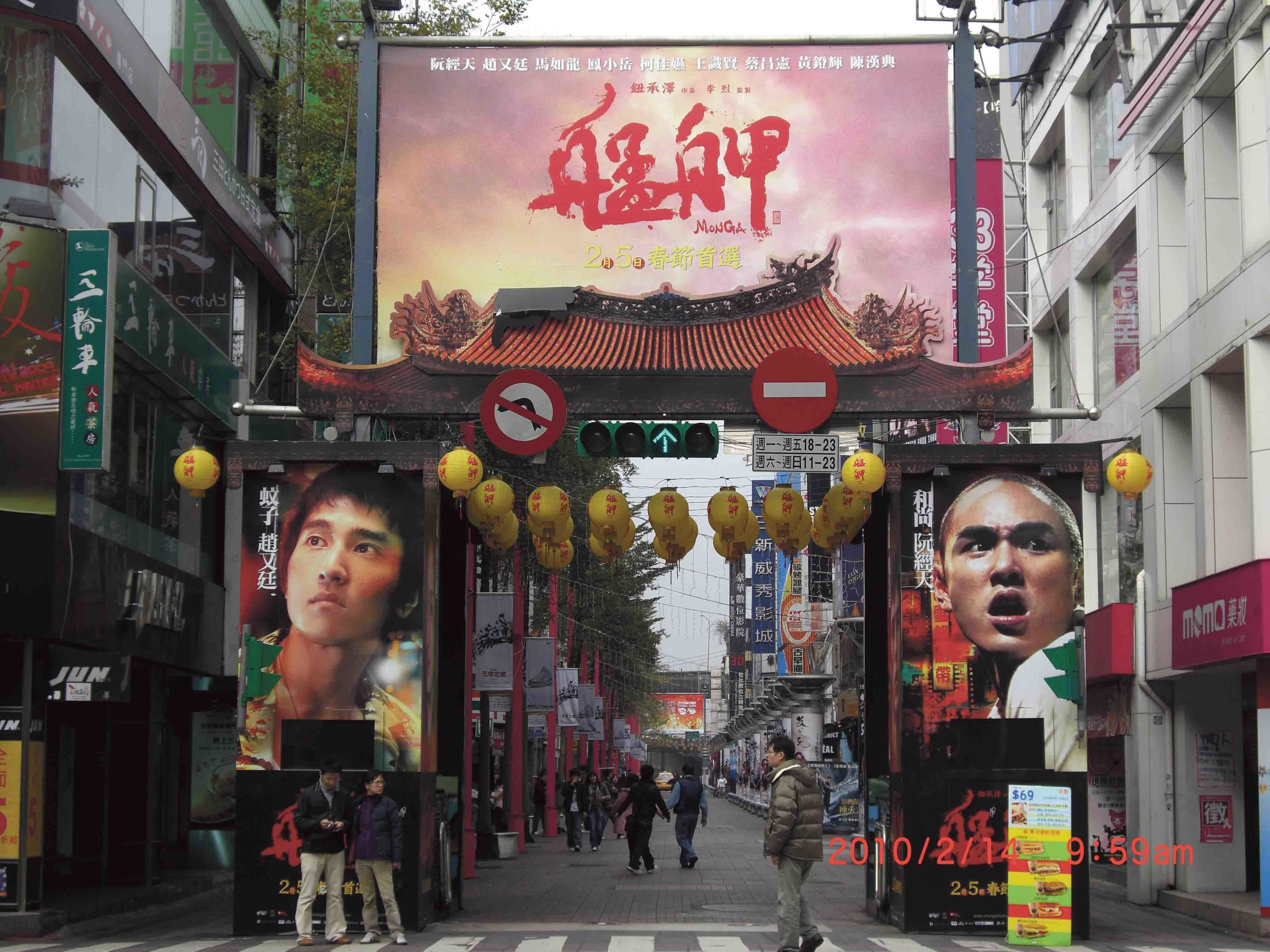
In 2010, the movie Monga hit the screens and became a driver of tourism and economic benefits to the Bangka area.
Hungry – Sampling of Foods Made Famous on Film
After visiting locations from the movie, it's time for a bite to eat. You may want to sample some of the foods that appeared in the film. Monga director Doze Niu (鈕承澤) has said that in the movie except for the roast chicken leg which was prepared by crew members, all of the other foods that were depicted were authentic local Bangka snacks and drinks, such as delicious meat congee from Bangka Old Street where people line up to buy it, baked pepper buns (胡椒餅), thick squid soup (魷魚羹), and herbal tea. He also shared stories of hospitality, saying that the local residents and shop owners were very friendly and
enthusiastic. They often brought food and drinks to give to the cast and crew, which Niu found very touching. In fact, the tolerance and passion of Bangka residents has not diminished over the course of 300 years. Due to the release of Monga, business at local shops has increased several fold along with the rise in local tourism.
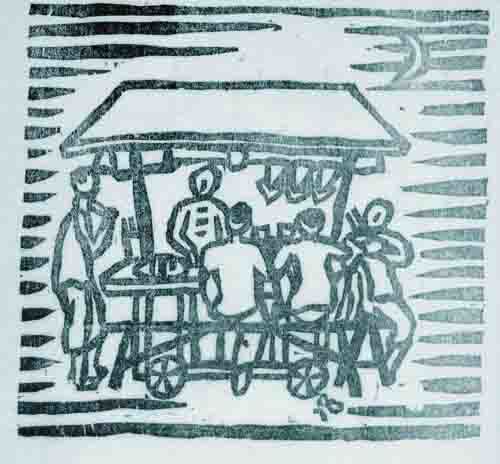
In the 1940's Japanese painter Tateishi Tetsuomi painted street and restaurant scenes of Bangka.
The Collective Living Memory of Taipei Natives
Although central Wanhua's Bangka does not possess nationally famous eateries, such as Ay-Chung Flour-Rice Noodle (阿宗麵線) or Shanghai Laotienlu (上海老天祿) located in northern Wanhua's Ximending, it does have the highest concentration and quantity of night markets, local snack shops and eateries in all of Taiwan. Among them, there is no lack of delicious snacks that are famed throughout Taipei City.
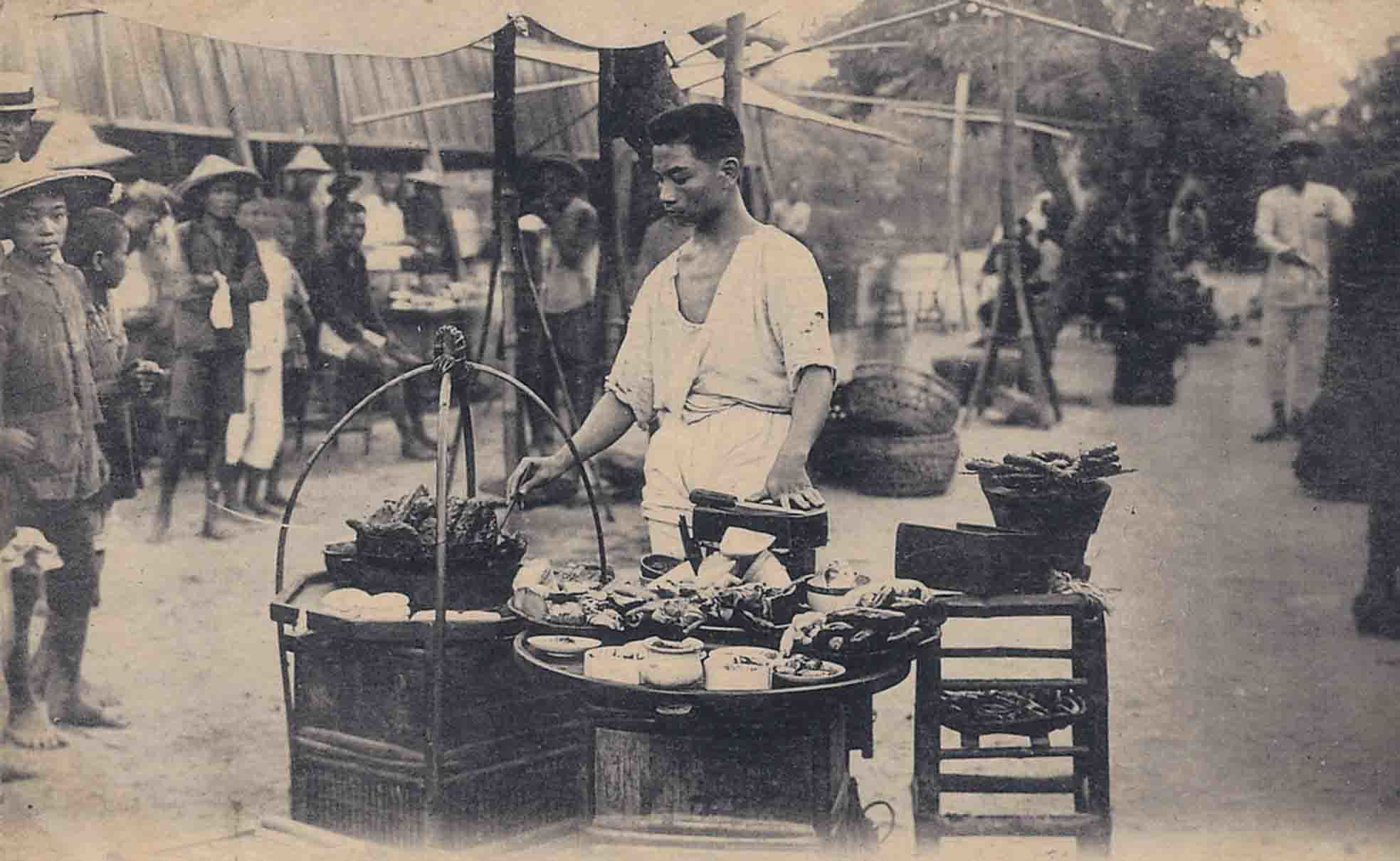
Long ago, Taiwan's food culture mostly developed around temple gates.
At any time from five or six o’clock in the morning to two or three o'clock at night you can enjoy a gastronomic feast in Bangka. A good number of the local traditional snacks were developed in the 1920s during the Japanese era or the post-war 1950s with an average of at least six decades of history. Some of the hundred-year-old shops have been established for three or four generations. Bangka is the birthplace of Taipei City, and its local delicacies and flavors are a part of many elderly people’s collective memory.
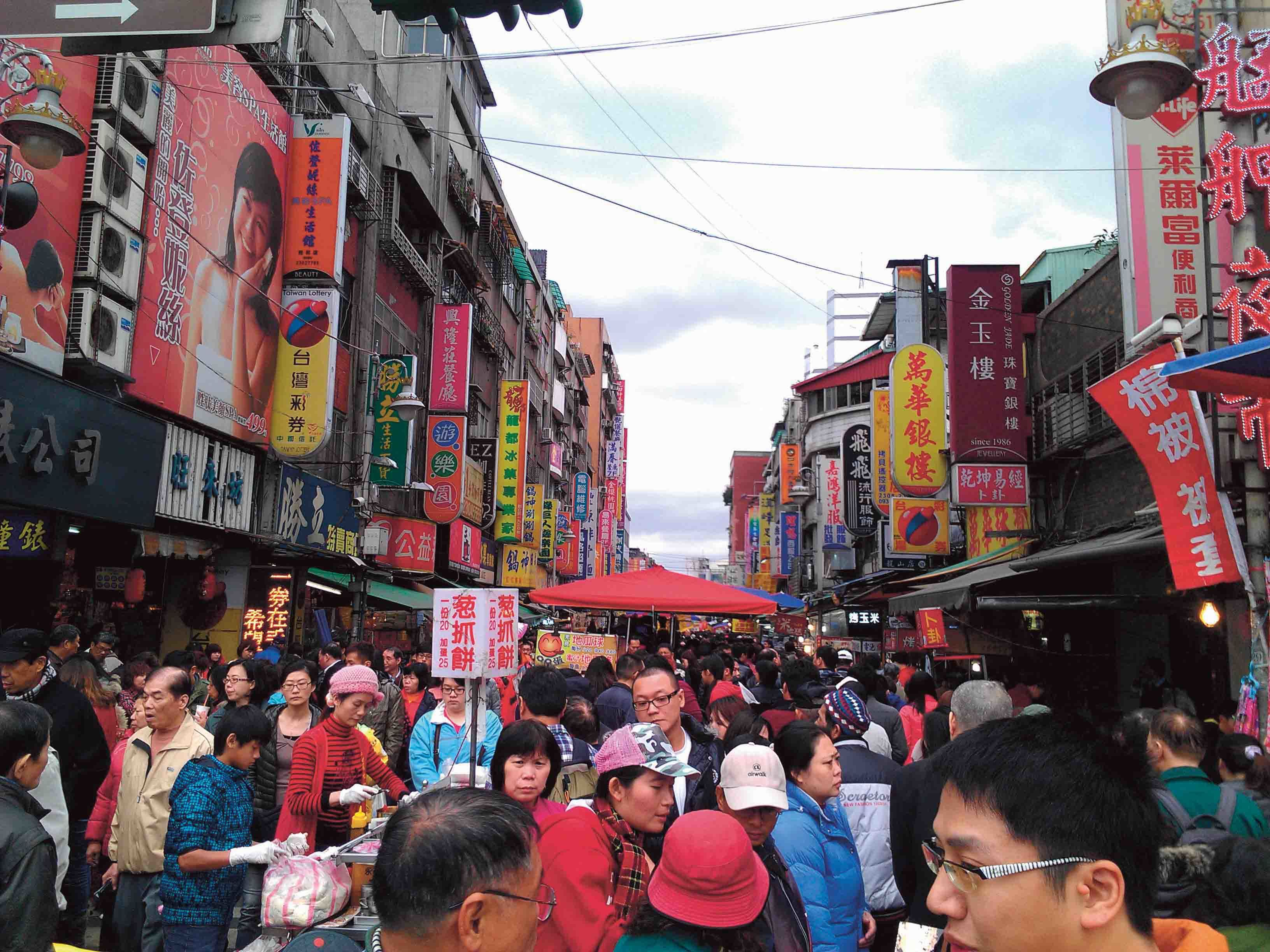
Eateries can be found everywhere near Longshan Temple in Bangka offering delicious bargains.
The foods, beverages, and snacks that can be found near the gates of the important temples in Bangka embody the lifestyles and culture of the common people. Early on, the temple gates were centers for finding employment, getting information, and exchanging ideas. From ancient times to the present they have been the sites for numerous food stalls and restaurants filling stomachs and satisfying appetites.
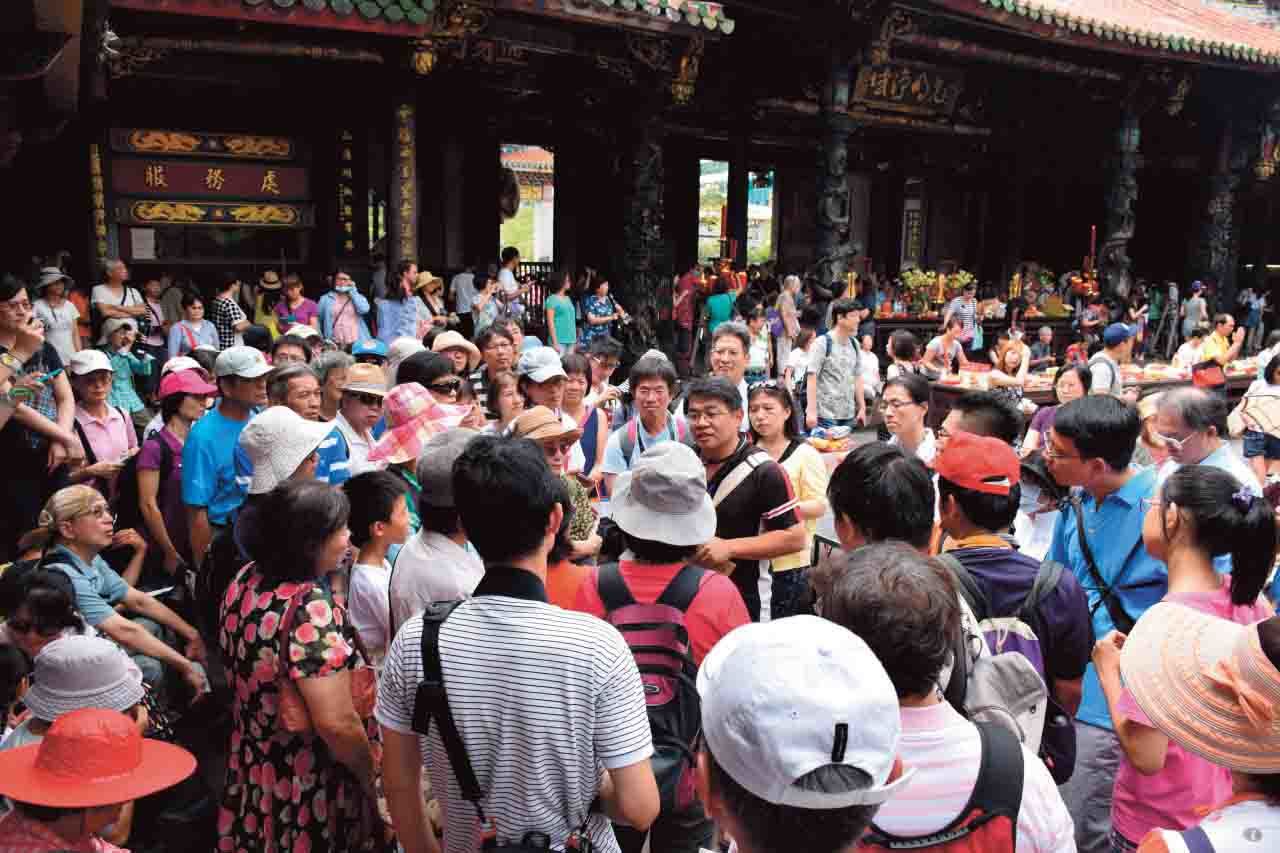
Bangka Historical Tour participants listen in earnest to this author's (wearing black in the middle) explanations. (Photo: Huang Licun)
Culinary Culture at the Temple Gates
From the Qing Dynasty to the present, due to the dispensing of herbal swabs in the history of the Longshan Temple, Herb Alley developed. As traditional cakes were eaten at various folk festivals, in addition to shops selling traditional cakes, those offering popular delicacies and snacks popped up in the area between Longshan Temple and Bangka Park. These include Fuzhou Yuanzu Baked Pepper Bun (福州元祖胡椒餅), 36 Tangyuan Shop, Su Family Meatballs and Oil Cake ( 蘇家肉圓油粿), Top Royal Vegetarian Dumplings (頂皇家素食水煎包), Liang Xi Hao Squid Soup (兩喜號魷魚羹), Xiangjia Swordfish Rice Flour Noodle Soup (香佳旗魚米粉湯), Songping Chicken (淞品土雞), and Taiho Traditional Biscuit.
There are several other noteworthy eateries near the Bankga Zushi Temple including Pork Rib King (原汁排骨大王), Sunway Restaurant (三味食堂) , Dongxiantang Taiwanese Traditional Drinks ( 冬仙堂冬瓜茶飲) , Sanjusangendo Temple Japanese Restaurant (三十三間堂日本料理), and a traditional store selling Yugui, or oil cake (油粿), and pork thick soup (肉羹湯) at the entrance of Zhixing Market (直興市場). Furthermore, Huanghefa Rice Pudding (黃合發米粿店), Yifeizi Noodle Shop (一肥仔麵店), A Tsai Ma’s Savory Soup Balls in Sweet Soup (阿猜嬤甜湯鹹圓), Bangka Traditionalstyle Cold Jelly (艋舺古早味涼粉), and Bangka Salty Congee ( 艋舺鹹粥) are all located near the Bangka Qingshan Temple (艋舺青山宮).
Snacks in the Tourist Night and Traditional Markets
Taiwan’s first tourist night market, Huaxi Street Tourist Night Market, is located in Bangka and features a wide assortment of delicious eateries and stalls selling numerous snacks including Tainan Dan Zai Noodles (台南擔仔麵), Xiaowang Steamed Minced Pork with Pickles in Broth (小王清湯瓜仔肉), Beigang Sweet Soup (北港甜湯), Dading Meat Thick Soup (大肉羹),Snake Meat Soup (蛇肉湯), Changhong Noodle Shop ( 昶鴻麵店), and Yuanfang Guabao (源芳割包), all of which are touristfavorites.
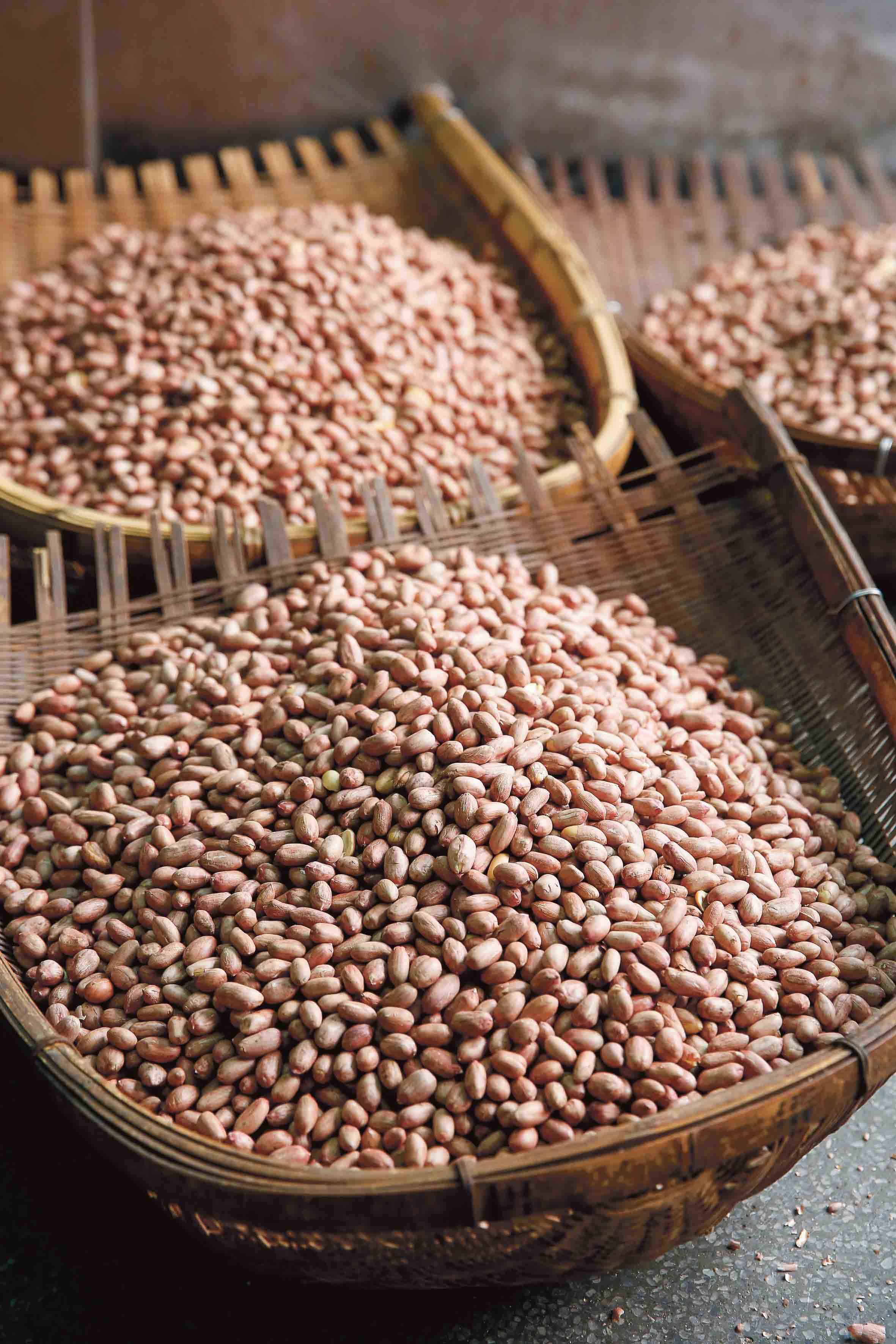
Large and round five-spice peanuts at Sanshui Foods. (Photo: Jilin Yang)
Near this tourist night market is the famed Guanzhou Street and Wuzhou Street night market, which is home to Huainian AiyuJelly( 懷念愛玉冰), Dingji Tempura (頂級甜不辣), Longdu Fruit Ice Desserts (龍都冰果室), Fengyuan Pork Noodles with Spare Ribs(豐原排骨麵), Aunt Ajiao Grilled Squid (阿嬌姨烤魷魚), and Baozihao Pig's Knuckle (寶字號豬腳). In the area near the Xinfu Market, which is celebrating its 80th anniversary this year, diners can enjoy local flavors at Ah Po Glutinous Oil Rice (阿婆油飯), Da Fong Fish Ball (大豐魚丸), Kam Wo Sushi Shop (金禾壽司), Wanhe Sashimi (丸合生魚片), and peanuts at Sanshui Foods, all of which feature possess long histories. That is not a l l , Bangka’s cuisine includes so much more. Near the BopiliaoHistoric Block are Zhouji Minced Meat Congee (周記肉粥), Axiu Noodles (阿秀切仔麵) and Jincai Noodles ( 進財切仔麵), Yixin Goose Meat (一心鵝肉), and Longlai Juice ( 龍來果汁) all of which are highly recommended by diners. Leaving Bopiliao and walking towards the border of Bangka and Xiakan (下坎) there is a strip of restaurants on Section 3, Heping West Road, including Bangka Ah Long Fried Rice and Noodles (艋舺阿龍炒飯), Rehai Fresh Seafood Restaurant (熱海現撈海鮮店), Li Family Stewed Chicken Palm (李家滷雞腳), Wanhua Chenji Specialty Oyster Noodles (萬華陳記專業蚵仔麵線), Hai Tian Dumplings Shop (海天香餃), and Budai Fresh Oysters (布袋鮮の蚵), whereas Wanhua Grass Jelly Ice (萬華仙草冰) and Liuzhou Snail Rice Noodle (柳州螺螄粉) are situated on Bangka Boulevard. Therefore, not much effort is needed to find good food in Bangka, and restaurants that are highly recommended by experienced guides can be found every few steps.
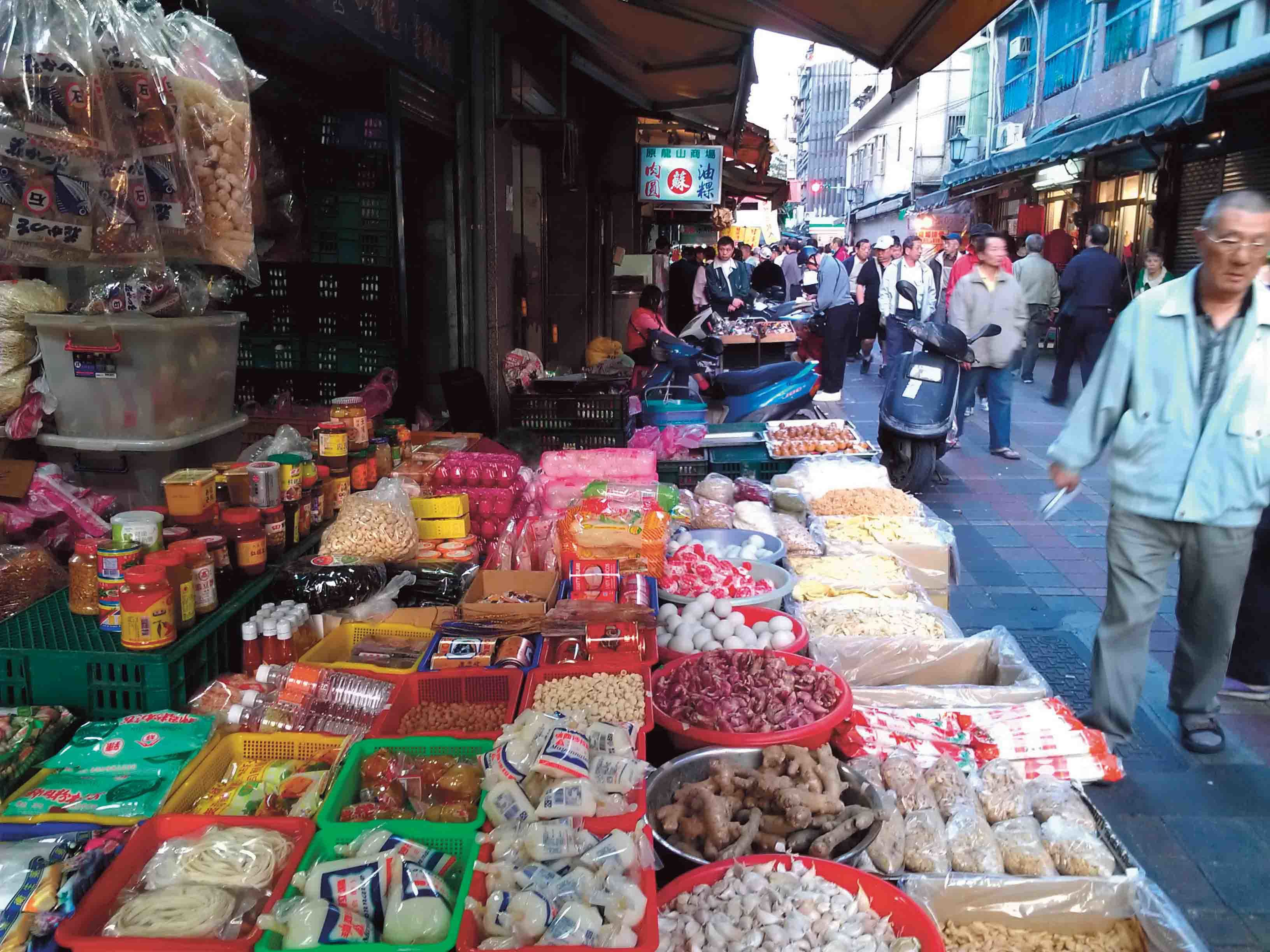
On Sanshui Street, there are still many eateries serving traditional foods and stores selling dry goods.
Bangka Historical Tour – Sampling Local Foods
To revive Bangka Park, in August and September the Taipei City Government promoted Bangka area tourism and indepth travel, collaborating with the writer to organize weekend guided tours for Taipei residents and backpackers and to create a street map as a guide to exploring Bangka’s history and interesting sites.
In addition to exploring Banka’s landscapes, traditional shops and markets, these guided tours allowed participants to sample some of Bangka’s delicacies at local favorites such as herbal tea at Tianxun Herb Shop (天順青草行), steamed taro cake (芋粿巧) and herbal rice cake (草仔粿) at 36 Tangyuan Shop, specialty cheese snack at Taiho Traditional Biscuit, stir fried peanuts at Sanshui Foods and Ah Po Glutinous Oil Rice in the Xinfu Market. All of these shops and eateries have several characteristics in common. In addition to long histories, they have won awards and appeared in numerous newspaper and media reports. The stir fried peanuts at Sanshui Foods have even been selected as in-flight snacks on EVA Airlines and China Airlines.
With more than ten generations of ancestors over 300 years living in Bangka, the writer sincerely looks forward to continued cooperation with the government and private sector to introduce Bangka’s genuine beauty to people all over Taiwan and even all over the world, especially the local delicacies and snacks to raise awareness of Taipei’s authentic dishes.
Bangka is a historical, cultural, and architectural landscape, with too many types of snacks and delicacies to count. In the past, not many domestic or foreign tourists explored the streets on their own to gain a true understanding of this neighborhood. When the movie Monga hit theaters in 2010, it not only introduced Taiwanese people to this old area of Taipei, but also brought a wave of tourism to Wanhua.

Bangka’s historical and cultural landscapes are abundant and diverse. However, in the past there were not many
domestic or foreign tourists who walked this area on their own.
In addition to praying for peace, happiness, and success at Longshan Temple, tourists began to visit some of the film's locations, such as the home of gang leader Geta in the Bopiliao Historic Block, the Taiyang Book Binding Factory, the place where members of the “Gang of Princes (太子幫)” were sworn in, Bangka Zushi Temple, the Huaxi Street Tourist Night Market, where gang fights took place, the alley adjacent to the Kushanyuan Hotel (古山園旅社) and Baodou Li ( 寶斗里), where the male and female leads met and developed feelings for one another. All of these places have become popular attractions.

In 2010, the movie Monga hit the screens and became a driver of tourism and economic benefits to the Bangka area.
Hungry – Sampling of Foods Made Famous on Film
After visiting locations from the movie, it's time for a bite to eat. You may want to sample some of the foods that appeared in the film. Monga director Doze Niu (鈕承澤) has said that in the movie except for the roast chicken leg which was prepared by crew members, all of the other foods that were depicted were authentic local Bangka snacks and drinks, such as delicious meat congee from Bangka Old Street where people line up to buy it, baked pepper buns (胡椒餅), thick squid soup (魷魚羹), and herbal tea. He also shared stories of hospitality, saying that the local residents and shop owners were very friendly and
enthusiastic. They often brought food and drinks to give to the cast and crew, which Niu found very touching. In fact, the tolerance and passion of Bangka residents has not diminished over the course of 300 years. Due to the release of Monga, business at local shops has increased several fold along with the rise in local tourism.

In the 1940's Japanese painter Tateishi Tetsuomi painted street and restaurant scenes of Bangka.
The Collective Living Memory of Taipei Natives
Although central Wanhua's Bangka does not possess nationally famous eateries, such as Ay-Chung Flour-Rice Noodle (阿宗麵線) or Shanghai Laotienlu (上海老天祿) located in northern Wanhua's Ximending, it does have the highest concentration and quantity of night markets, local snack shops and eateries in all of Taiwan. Among them, there is no lack of delicious snacks that are famed throughout Taipei City.

Long ago, Taiwan's food culture mostly developed around temple gates.
At any time from five or six o’clock in the morning to two or three o'clock at night you can enjoy a gastronomic feast in Bangka. A good number of the local traditional snacks were developed in the 1920s during the Japanese era or the post-war 1950s with an average of at least six decades of history. Some of the hundred-year-old shops have been established for three or four generations. Bangka is the birthplace of Taipei City, and its local delicacies and flavors are a part of many elderly people’s collective memory.

Eateries can be found everywhere near Longshan Temple in Bangka offering delicious bargains.
The foods, beverages, and snacks that can be found near the gates of the important temples in Bangka embody the lifestyles and culture of the common people. Early on, the temple gates were centers for finding employment, getting information, and exchanging ideas. From ancient times to the present they have been the sites for numerous food stalls and restaurants filling stomachs and satisfying appetites.

Bangka Historical Tour participants listen in earnest to this author's (wearing black in the middle) explanations. (Photo: Huang Licun)
Culinary Culture at the Temple Gates
From the Qing Dynasty to the present, due to the dispensing of herbal swabs in the history of the Longshan Temple, Herb Alley developed. As traditional cakes were eaten at various folk festivals, in addition to shops selling traditional cakes, those offering popular delicacies and snacks popped up in the area between Longshan Temple and Bangka Park. These include Fuzhou Yuanzu Baked Pepper Bun (福州元祖胡椒餅), 36 Tangyuan Shop, Su Family Meatballs and Oil Cake ( 蘇家肉圓油粿), Top Royal Vegetarian Dumplings (頂皇家素食水煎包), Liang Xi Hao Squid Soup (兩喜號魷魚羹), Xiangjia Swordfish Rice Flour Noodle Soup (香佳旗魚米粉湯), Songping Chicken (淞品土雞), and Taiho Traditional Biscuit.
There are several other noteworthy eateries near the Bankga Zushi Temple including Pork Rib King (原汁排骨大王), Sunway Restaurant (三味食堂) , Dongxiantang Taiwanese Traditional Drinks ( 冬仙堂冬瓜茶飲) , Sanjusangendo Temple Japanese Restaurant (三十三間堂日本料理), and a traditional store selling Yugui, or oil cake (油粿), and pork thick soup (肉羹湯) at the entrance of Zhixing Market (直興市場). Furthermore, Huanghefa Rice Pudding (黃合發米粿店), Yifeizi Noodle Shop (一肥仔麵店), A Tsai Ma’s Savory Soup Balls in Sweet Soup (阿猜嬤甜湯鹹圓), Bangka Traditionalstyle Cold Jelly (艋舺古早味涼粉), and Bangka Salty Congee ( 艋舺鹹粥) are all located near the Bangka Qingshan Temple (艋舺青山宮).
Snacks in the Tourist Night and Traditional Markets
Taiwan’s first tourist night market, Huaxi Street Tourist Night Market, is located in Bangka and features a wide assortment of delicious eateries and stalls selling numerous snacks including Tainan Dan Zai Noodles (台南擔仔麵), Xiaowang Steamed Minced Pork with Pickles in Broth (小王清湯瓜仔肉), Beigang Sweet Soup (北港甜湯), Dading Meat Thick Soup (大肉羹),Snake Meat Soup (蛇肉湯), Changhong Noodle Shop ( 昶鴻麵店), and Yuanfang Guabao (源芳割包), all of which are touristfavorites.

Large and round five-spice peanuts at Sanshui Foods. (Photo: Jilin Yang)
Near this tourist night market is the famed Guanzhou Street and Wuzhou Street night market, which is home to Huainian AiyuJelly( 懷念愛玉冰), Dingji Tempura (頂級甜不辣), Longdu Fruit Ice Desserts (龍都冰果室), Fengyuan Pork Noodles with Spare Ribs(豐原排骨麵), Aunt Ajiao Grilled Squid (阿嬌姨烤魷魚), and Baozihao Pig's Knuckle (寶字號豬腳). In the area near the Xinfu Market, which is celebrating its 80th anniversary this year, diners can enjoy local flavors at Ah Po Glutinous Oil Rice (阿婆油飯), Da Fong Fish Ball (大豐魚丸), Kam Wo Sushi Shop (金禾壽司), Wanhe Sashimi (丸合生魚片), and peanuts at Sanshui Foods, all of which feature possess long histories. That is not a l l , Bangka’s cuisine includes so much more. Near the BopiliaoHistoric Block are Zhouji Minced Meat Congee (周記肉粥), Axiu Noodles (阿秀切仔麵) and Jincai Noodles ( 進財切仔麵), Yixin Goose Meat (一心鵝肉), and Longlai Juice ( 龍來果汁) all of which are highly recommended by diners. Leaving Bopiliao and walking towards the border of Bangka and Xiakan (下坎) there is a strip of restaurants on Section 3, Heping West Road, including Bangka Ah Long Fried Rice and Noodles (艋舺阿龍炒飯), Rehai Fresh Seafood Restaurant (熱海現撈海鮮店), Li Family Stewed Chicken Palm (李家滷雞腳), Wanhua Chenji Specialty Oyster Noodles (萬華陳記專業蚵仔麵線), Hai Tian Dumplings Shop (海天香餃), and Budai Fresh Oysters (布袋鮮の蚵), whereas Wanhua Grass Jelly Ice (萬華仙草冰) and Liuzhou Snail Rice Noodle (柳州螺螄粉) are situated on Bangka Boulevard. Therefore, not much effort is needed to find good food in Bangka, and restaurants that are highly recommended by experienced guides can be found every few steps.

On Sanshui Street, there are still many eateries serving traditional foods and stores selling dry goods.
Bangka Historical Tour – Sampling Local Foods
To revive Bangka Park, in August and September the Taipei City Government promoted Bangka area tourism and indepth travel, collaborating with the writer to organize weekend guided tours for Taipei residents and backpackers and to create a street map as a guide to exploring Bangka’s history and interesting sites.
In addition to exploring Banka’s landscapes, traditional shops and markets, these guided tours allowed participants to sample some of Bangka’s delicacies at local favorites such as herbal tea at Tianxun Herb Shop (天順青草行), steamed taro cake (芋粿巧) and herbal rice cake (草仔粿) at 36 Tangyuan Shop, specialty cheese snack at Taiho Traditional Biscuit, stir fried peanuts at Sanshui Foods and Ah Po Glutinous Oil Rice in the Xinfu Market. All of these shops and eateries have several characteristics in common. In addition to long histories, they have won awards and appeared in numerous newspaper and media reports. The stir fried peanuts at Sanshui Foods have even been selected as in-flight snacks on EVA Airlines and China Airlines.
With more than ten generations of ancestors over 300 years living in Bangka, the writer sincerely looks forward to continued cooperation with the government and private sector to introduce Bangka’s genuine beauty to people all over Taiwan and even all over the world, especially the local delicacies and snacks to raise awareness of Taipei’s authentic dishes.
 TAIPEI 2015Winter Vol.02—Taipei Natives Relish Local Flavors Day and Night
TAIPEI 2015Winter Vol.02—Taipei Natives Relish Local Flavors Day and Night